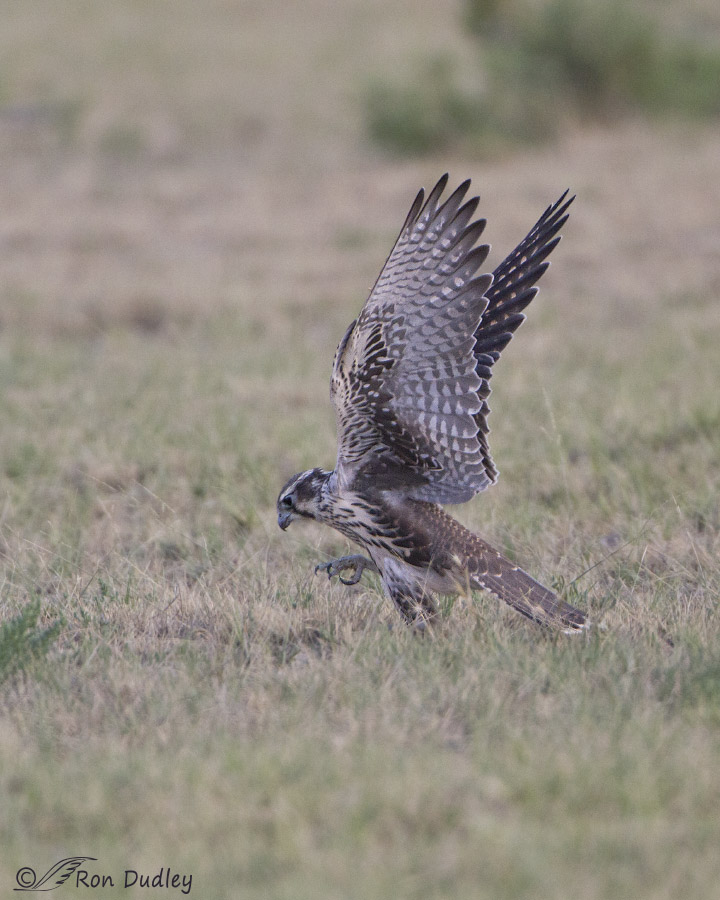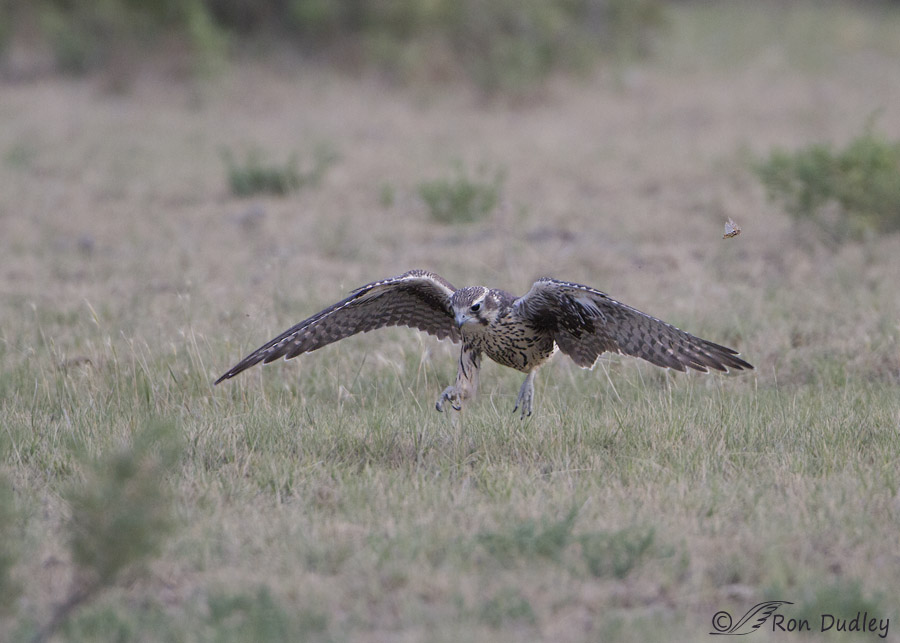Grasshoppers are not typical prey for Prairie Falcons. Studies indicate that the main foods taken are other birds (Horned Larks and meadowlarks are favorites), small mammals and lizards but in a pinch they do consume flying insects, including grasshoppers. This bird was intent on doing just that.
Note: Lighting for these shots was dismal at best (it was simply too dark for bird photography) so I had to process these images within an inch of their lives to make them reasonably presentable, even as documentary images. But I do think the demonstrated behavior is interesting.

1/2500, f/5.6, ISO 800, Canon 7D, Canon EF500mm f/4L IS USM +1.4x
I photographed this falcon in July of 2013 at Montana’s Red Rock Lakes National Wildlife Refuge. At first the bird was perched but just as a violent storm squall moved in (with attendant high winds and dark, threatening clouds) it began to hunt grasshoppers in the short grass. It was so dark and windy (the wind was catching my lens hood and bouncing my lens around) that I knew I’d have to use extraordinary measures to get sufficient shutter speeds for sharp shots so I deliberately underexposed the images (allowing for more SS) and hoped I could rescue the photos during processing. This is the best I could do but I’d rather have the bird sharp and the image quality poor than a soft bird with marginally better IQ.
It wasn’t easy to follow the falcon with a bouncing lens as it hunted frenetically but here I like the wing position and that large falcon foot poised to pounce on an unseen (by us) grasshopper.

1/1250, f/5.6, ISO 800, Canon 7D, Canon EF500mm f/4L IS USM +1.4x
A couple of minutes later it had become even darker (notice that my shutter speed has been reduced by half) as the bird jumped forward to pounce on another grasshopper. At this stage in their metamorphosis the insects had wings and through my lens I could see them frantically trying to fly out of harms way. Here you can see one of them in flight above the tip of the falcons left wing.
Prairie Falcons have been scarce to nonexistent on Antelope Island this winter but recently I’ve seen two of them out there. I suspect that’s because of the recent spring influx of Western Meadowlarks and Horned Larks so I do have hopes of photographing them again soon.
Maybe this time I’ll get some light.
Ron


Fascinating behaviour. I suspect hunger was the drive – which I hate to hear.
Love the details on the plumage though.
EC, I suspect this bird was deliberately loading up with calories before the storm. Weather can turn atrocious and prey become scarce for extended periods up there, even at that time of year.
Yas! You sure is!!!
Beautiful!! I am always intrigued by the feathers on the underside of the wings. NICE!!! Thank you.
Me too, Karen – pretty neat patterns under there. Thanks.
Great action images and info Ron!
Thank you, John.
Even if they aren’t the best quality, these are still beautiful photos. I wish we’d see a Prairie Falcon around here again. The one we did have a couple of years ago caught and ate a Great-tailed Grackle.
A grackle would be pretty good sized prey for these birds, Susan.
The posture is intriguing. It looks a bit like a cat!
It was as quick as a cat too, Arwen.
Bouncing bird following bouncing prey being photographed through a bouncing lens…quite a challenge! Bet when you were born, you were a bouncing boy. Love the wing positions in both images…
Whaddy’a mean, Patty. I’m STILL a bouncing boy…
Hi Ron,
Very nice! One of my favorite birds. It’s a youngster – I wonder if that had anything to do with the prey choice and hunting behavior…?
Thanks!
Cheers,
Dick
I wondered the same thing, Dick. Another prairie I photographed in the area as it ate grasshoppers was also a young bird.
Amazing shots under those conditions!
Charlotte
Thanks, Charlotte.
what mode are you shooting? Looks like aperture priority. Try Manual with Auto ISO. Can then maintain shutter speed for sharpness and let the ISO compensate. Set upper limit on ISO so not to let it go crazy. I get great results in M mode and Auto ISO with the Canon 7D2 and 100-400 Mark 2. Cheers, Rich
Thanks for the tip, Richard but in my experience I lose more than I gain when I shoot the older 7D at ISO’s above 800 so I try to avoid that at all costs. Auto ISO wouldn’t allow me to do that in these situations. I also prefer to shoot in aperture priority. Old dogs and new tricks, ya know…